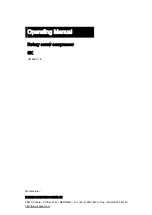
13-8-619 Page 31
THERMAL CONTROL (THERMOSTATIC MIXING) VALVE
is installed in the system. This valve is used
to control the temperature of the oil. On start-up with unit cold, the element is open to bypass, allowing oil
to pass directly from the reservoir to the compressor during warm-up. As oil warms, the element
gradually closes to the bypass allowing more of the oil from the cooler to mix with oil from the bypass.
After the unit is warmed up, the mixing valve maintains oil injection temperature into the compressor at a
minimum of 170
°
F (77
°
C). This system provides proper compressor warm-up and prevents moisture
contamination of the oil.
To check the element, heat in oil - it should be fully extended at 170
°
F (77
°
C). If the unit shuts down due
to high air discharge temperature, the cause may be that the element is stuck open to the bypass. When
flushing the oil system, remove the mixing valve and clean all parts thoroughly.
OIL RESERVOIR
- The oil reservoir-separator combines multiple functions into one vessel. The lower
half is the oil reservoir, providing oil storage capacity for the system and the top portion, a primary oil
separation means. The reservoir also provides limited air storage for control and gauge actuation.
COMPRESSOR (G-D ELIMINATOR) OIL SEPARATOR
located in a separate housing, consists of a
renewable cartridge-type separator element and provides the final removal of oil from the air stream.
Oil impinging on the inside of the separator element drains directly back into the oil reservoir by gravity.
Oil collected outside the element is returned through tubing to the compressor cylinder.
Oil carry-over through the service lines may be caused by a faulty oil separator, overfilling of the oil
reservoir, oil that foams, oil return line malfunction, or water condensate in the oil. If oil carryover occurs,
inspect the separator only after it is determined that the oil level is not too high, the oil is not foaming
excessively, the oil return tube from the bottom of the separator to the compressor cylinder is not clogged
or pinched off, the check valve in the oil return is functioning properly, and there is not water or an
oil/water emulsion in the oil.
Oil carry-over malfunctions of the oil separator are usually due to using elements too long, heavy dirt or
varnish deposits caused by inadequate air filter service, use of improper oil, or using oil too long for
existing conditions. Excessive tilt angle of the unit will also hamper separation and cause oil carry-over.
Oil separator element life cannot be predicted; it will vary greatly depending on the conditions of
operation, the quality of the oil used and the maintenance of the oil and air filters. The condition of the
separator can be determined by pressure differential or by inspection.
Pressure Differential Gauging
1. Be sure the unit is completely off and that no air pressure is in the oil reservoir.
2. Disconnect, lockout and tagout the power supply to the starter.
3. Install accurate pressure gauges upstream and downstream of the air/oil separator.
4. If the differential pressure is greater than 8 psi (.6 bar), change the air/oil separator, see “Removal of
Oil Separator For Inspection or Replacement”, page 32.
CAUTION
Using an oil separator element at excessive pressure differential can cause
damage to equipment. Replace the separator every year or when the pressure
drop across the separator reaches 8 psi.
Содержание INTEGRA EFB99A
Страница 9: ...13 8 619 Page 2 300EFB797 A Ref Drawing Figure 1 2 COMPRESSOR ILLUSTRATION...
Страница 12: ...13 8 619 Page 5 DECALS 206EAQ077 212EAQ077 218EAQ077 211EAQ077 207EAQ077...
Страница 13: ...13 8 619 Page 6 DECALS 216EAQ077 217EAQ077 222EAQ077 221EAQ077 208EAQ077...
Страница 30: ...13 8 619 Page 23 300EFB542 C Ref Drawing Figure 4 3 WIRING DIAGRAM...
















































